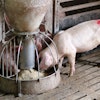
Vilsack unveils new plan that aims to distribute COVID-19 financial assistance more equitably
The U.S. Department of Agriculture (USDA) will dedicate US$6 billion toward new programs that will reach a broader set of agricultural producers than previous COVID-19 aid programs.
In an announcement on March 24, USDA said it would also develop rules for new programs that will put a greater emphasis on outreach to small and socially disadvantaged producers, specialty crop and organic producers, timber harvesters, and support for the food supply chain and producers of renewable energy, among others.
“The pandemic affected all of agriculture, but many farmers did not benefit from previous rounds of pandemic-related assistance,” said Agriculture Secretary Tom Vilsack in a statement. “The Biden-Harris Administration is committed to helping as many producers as possible, as equitably as possible.”
Four-part plan
USDA said the pandemic assistance would be distributed in four parts.
Part 1: US$6 billion to expand help and assistance to more producers
The new programs would include assistance for, among other things:
- Dairy farmers through the Dairy Donation Program or other means
- Euthanized livestock and poultry
- Costs for organic certification or to continue or add conservation activities
- Other possible expansion and corrections to the Coronavirus Food Assistance Program such as to support dairy or other livestock producers
- Personal protective equipment (PPE) and other protective measures for food and farm workers and specialty crops and seafood processors and distributors
- Improving the resilience of the food supply chain
- Developing infrastructure to support donation and distribution of perishable commodities, including food donation and distribution through farm-to-school, restaurants, or other community organizations
- Reducing food waste
Part 2: US$500 million in new funding to existing programs
This new assistance includes:
- US$20 million for the Animal and Plant Health Inspection Service to improve and maintain animal disease prevention and response capacity, including the National Animal Health Laboratory Network
- US$20 million for the Agricultural Research Service to work collaboratively with Texas A&M on the critical intersection between responsive agriculture, food production, and human nutrition and health
- US$28 million for NIFA to provide grants to state departments of agriculture to expand or sustain existing farm stress assistance programs
Part 3: Carrying out formula payments under CFAP 1, CFAP 2 and CFAP AA
USDA will expedite provisions under the Consolidated Appropriations Act 2021, including:
- An increase in CFAP 1 payment rates for cattle. Cattle producers with approved CFAP 1 applications will automatically receive these payments beginning in April. USDA estimates additional payments of more than US$1.1 billion to more than 410,000 producers, according to the mandated formula.
- Additional CFAP assistance of US$20 per acre for producers of eligible crops identified as CFAP 2 flat-rate or price-trigger crops beginning in April. This includes alfalfa, corn, hemp, rice, sorghum, soybeans and wheat, among other crops. FSA will automatically issue payments to eligible price trigger and flat-rate crop producers based on the eligible acres included on their CFAP 2 applications. USDA estimates additional payments of more than US$4.5 billion to more than 560,000 producers, according to the mandated formula.
- USDA will finalize routine decisions and minor formula adjustments on applications and begin processing payments for certain applications filed as part of the CFAP Additional Assistance program in the following categories:
- Applications filed for pullets and turfgrass sod
- A formula correction for row-crop producer applications to allow producers with a non-Actual Production History (APH) insurance policy to use 100% of the 2019 Agriculture Risk Coverage-County Option (ARC-CO) benchmark yield in the calculation
- Sales commodity applications revised to include insurance indemnities, Noninsured Crop Disaster Assistance Program payments, and Wildfire and Hurricane Indemnity Program Plus payments, as required by statute
- Additional payments for swine producers and contract growers under CFAP Additional Assistance remain on hold and are likely to require modifications to the regulation as part of the broader evaluation and future assistance; however, FSA will continue to accept applications from interested producers.
Part 4: Reopening CFAP 2 sign-up
USDA will re-open sign-up for of CFAP 2 for at least 60 days beginning on April 5, 2021.
- FSA has committed at least US$2.5 million to establish partnerships and direct outreach efforts intended to improve outreach for CFAP 2 and will cooperate with grassroots organizations with strong connections to socially disadvantaged communities to ensure they are informed and aware of the application process.
Vilsack shared details of the new plan during a virtual meeting with state farm bureau presidents and American Farm Bureau Federation (AFBF) leadership.
“We appreciate Secretary Vilsack’s action to release funds and expand eligibility for farmers hit hard by the devastating effects of COVID-19,” said AFBF President Zippy Duvall in a statement. “USDA’s decision to distribute aid based upon previous applications will help deliver assistance quickly. It was good to hear directly from the Secretary today about this program and his priorities going forward.”
View our continuing coverage of the novel coronavirus (COVID-19) pandemic.











